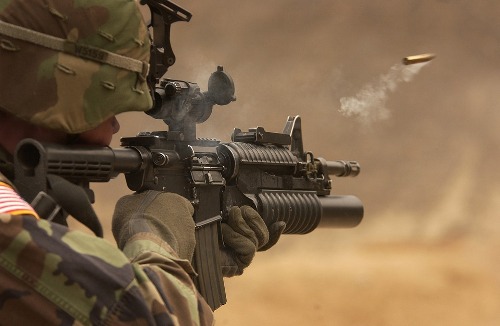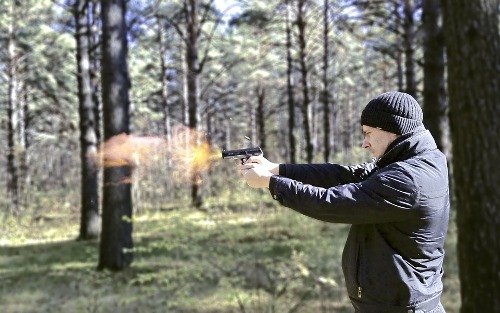Sending a bullet flying is easy, but having a thorough knowledge of your tool is way harder.
Have you ever wondered “How far can a bullet travel?” and “What factors influence a bullet’s distance?” and get frustrated for not knowing the answer?
Below are your answers in this concise article. Let’s scroll down to read!

Contents
How Far Can A Bullet Travel?
According to Paskiewicz, a bullet may travel within 12,000 feet ~ 1.5 miles. There are plenty of factors going into the travel of the bullet, weight, wind, trajectory, obstacles, or types of bullets & firearm. In particular, here are:
308 Bullet:
The 308 bullet – also known as the .308 Winchester – is probably one of America’s most easy-to-recognize bullets. Those in the Southern/Eastern region of the US will see this even more prominent as the bullet type almost dominates the market when it comes to hunting guns.
During optimal conditions in the US, the 308 bullets can go as far as 1000 yards. When you change the gun’s muzzle velocity to be around 2620 FPS, its bullet can cover a distance of 4600 yards. That should give you a safe range to aim around and adjust your shots better.
In addition, aiming upward into the air from a 45-degree angle will allow the bullet to reach 3.5 – 4.5 miles of height.

30-06 Bullet:
The 30-60 Springfield bullet is also just as popular as .308, and its range is also quite decent. A bullet of this type can easily hit the 400-yard distance mark. Some have tried testing the bullet during their hunts and discovered that they could reach closer and closer to the 15-yard mark but never really at it.
Though we still need more testing for this bullet, it is safe to assume that aiming with the 1000-yard range in mind is best for 30-60 bullet usage.
40 Caliber Bullet:
This bullet is quite similar among handguns users or sorts. The 40-caliber has great synergy with the convenient tool types simply because it is smaller and sleeker than other bullets in the current market.
Then with a backstop, how far can a 40-caliber go? Its maximum cap is at 6600 feet lately, according to professional testers.
45 Caliber Bullet:

45-Caliber – or 45 ACP is another great bullet that goes well with handguns and sub-machine guns. The firearm type will decide how far your bullet travels to widen your ammo’s distance range.
As expected, the 45 ACP can travel up to 27 yards before dropping when you shoot it out. Rare cases can happen, and in those scenarios, the bullet can hit the mark of 109 yards!
With submachine guns, that’s a different story. You should be able to fire the 45 ACP bullet at a target 220 yards away from where you’re standing. Firing upwards will give your bullet a total distance of 1700 yards.
What Are The Factors That Affect A Bullet’s Distance?
The bullet type and the firearm can drastically change how far the bullet may fly. It’s common sense that the bullet’s design should fit the firearm to better ensure the way it comes out of your gun. However, the matter is much deeper than that.
Let’s take a look at the elements that make or break a bullet’s flight.
Projectile Weight:
The weight of your projectile can heavily influence its flight route and distance. Specifically, if you match up two projectiles’ firing methods and speed in an optimal environment, the lighter one will fall behind its counterpart for sure.
This phenomenon is because the heavy projectile will be able to harness more momentum to keep going further. The bullet will keep on going until momentum weakens and air resistance causes it to slow down gradually. It’s not the same story with the light projectile, as it cannot keep going and fall more quickly.
The air resistance can significantly reduce the two projectiles’ velocities. Nonetheless, their landing spot is yards away from one another.
Muzzle Velocity:

Simply saying, muzzle velocity is the speed at which the bullet leaves the firearm’s muzzle. The more explosive in the cartridge and the longer the barrel, the faster the bullet will fly out of the firearm. Even if you try to use two identical projectiles to test two different firearms, you will still get different results.
The mechanism behind this factor is the same with changing projectile weight. If you put more velocity into the projectile, it has more momentum to carry throughout its journey, and the momentum will wear off much more slowly before air resistance can kick in.
Bullet Shape:
This aspect is quite simple aerodynamics. The affection of the air to the bullet is proportional to its shape. If your bullet is smaller or slimmer in shape, it will suffer less air resistance than bigger and thicker ones. Consequently, those larger bullets will fall way faster.
Other External Factors:
From these basic factors, you can think of how environmental changes can affect your bullet route and how far it can travel. Standing at a high-altitude region allows gunners to aim at further targets than at low-altitude ones. Explaining this phenomenon is the thickness and temperature of the air. The higher the position is, the thinner and colder the air is. Therefore, the bullet can cut through it much easier.
The wind – or how air moves around the globe’s surface – can make your bullet fall more quickly as well. There lies the reason why gunners keep a humidifier with their ammunition!
How Far Can A Bullet Travel In Water?
Air resistance is nothing compared to water resistance or any liquid of that matter. There is no definite answer to this question, as bullet shape and muzzle velocity continues to play a very important role in the experiment in a surprisingly different way.
In this case, pointed, thin, and fast bullets tend to travel a shorter distance in water as they will have more muzzle velocity, contributing to the water resistance that they will have to suffer.
Verdict
That’s everything we can provide on the topic of “How far can a bullet travel?”. There is no exact answer to this particular question, as many factors take part in the process.
Meticulously examining each factor will allow you to discover your bullet’s abilities. Even when you encounter a new type of bullet not included on our list, you can still figure out how to inspect it with such detailed information.

I am Jerry Gonzalez, and my heart beats for the great outdoors, especially in the breathtaking landscapes of Helena, Montana. Engaging with fellow enthusiasts online and at local hunting clubs has been a rewarding experience, and I find great joy in sharing knowledge and experiences with like-minded individuals. My goal is to empower my fellow hunters with well-informed choices, regardless of their experience level.
